MG412 Principles of Marketing: Haagen-Dazs vs. Ben & Jerry's Report
VerifiedAdded on 2023/01/12
|6
|1992
|66
Report
AI Summary
This report provides a comprehensive analysis of the marketing strategies employed by Haagen-Dazs and Ben & Jerry's, two leading luxury ice cream brands in the UK. The report delves into the brands' segmentation, targeting, and positioning (STP) strategies, examining their respective target markets and how they differentiate themselves. It then explores the brands' product mixes, utilizing Levitt's model to evaluate core, expected, potential, and augmented product levels, as well as brand personality. The analysis extends to pricing strategies, distribution networks (place), and promotional activities, including advertising, sponsorships, and social media presence. The report concludes with a comparative assessment of the effectiveness of the 4Ps (product, price, place, promotion) for each brand, offering recommendations for Ben & Jerry's and Haagen-Dazs to enhance their market presence and customer engagement. The report is based on a coursework assignment for the Principles of Marketing module (MG412).
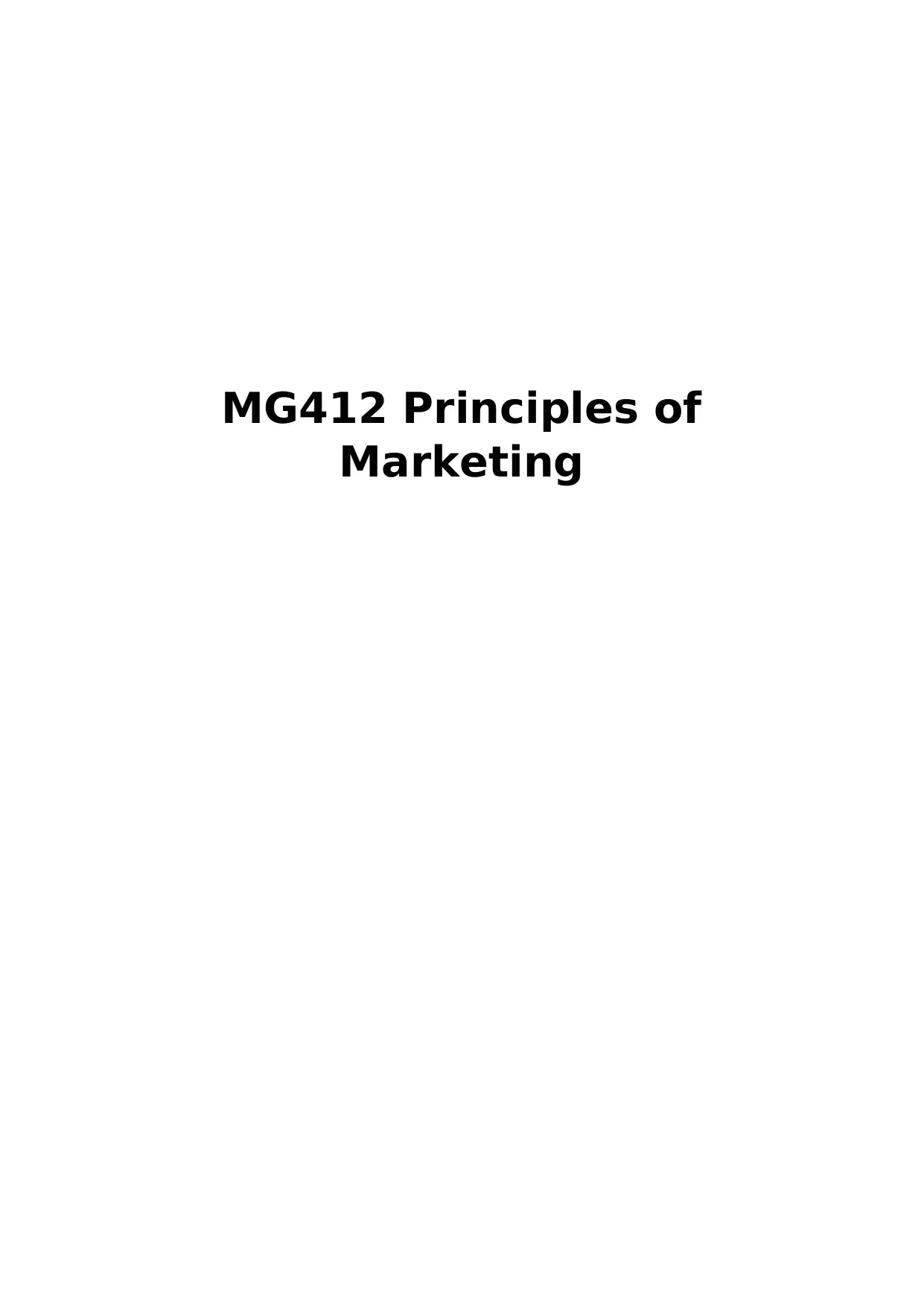
MG412 Principles of
Marketing
Marketing
Paraphrase This Document
Need a fresh take? Get an instant paraphrase of this document with our AI Paraphraser
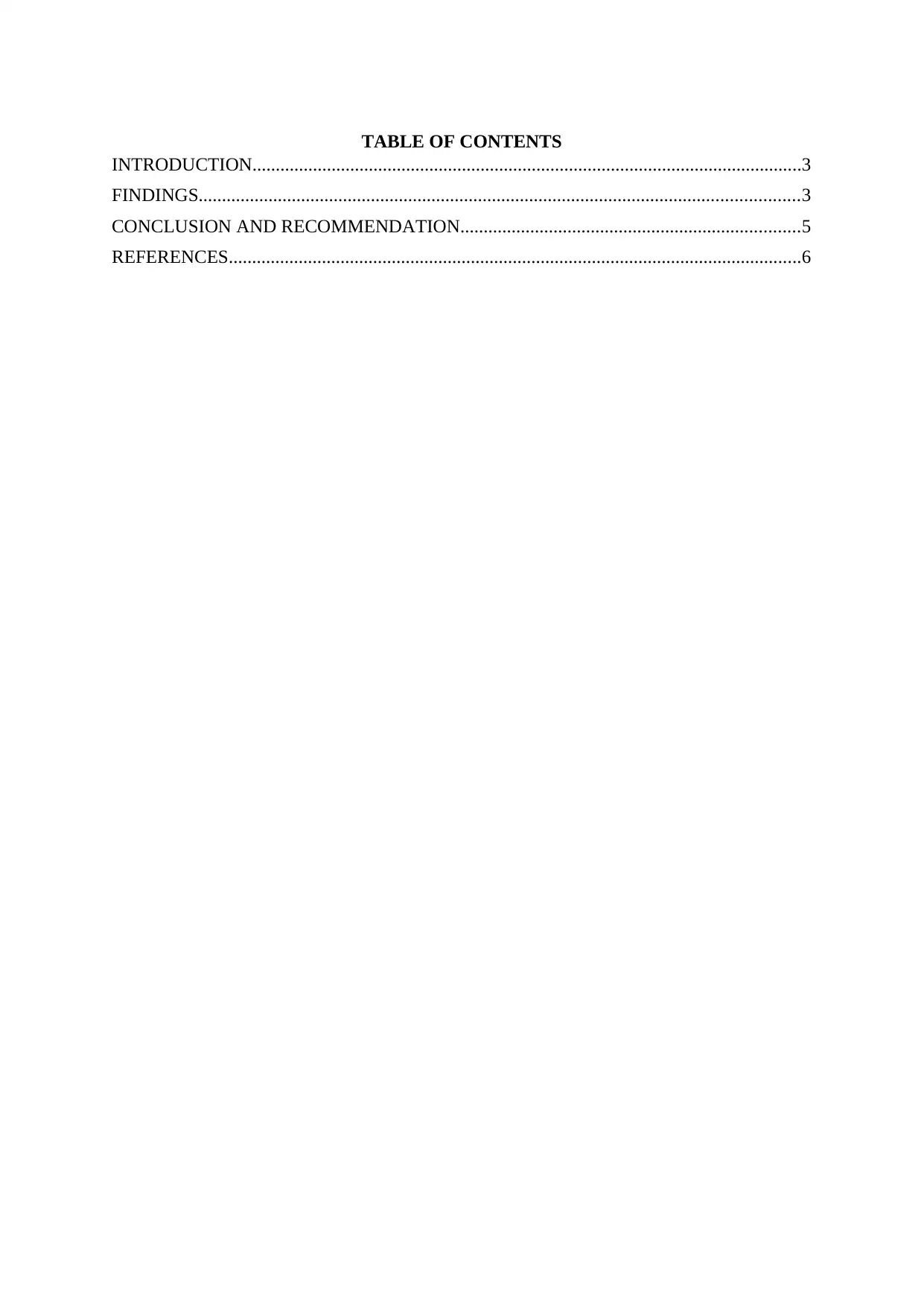
TABLE OF CONTENTS
INTRODUCTION......................................................................................................................3
FINDINGS.................................................................................................................................3
CONCLUSION AND RECOMMENDATION.........................................................................5
REFERENCES...........................................................................................................................6
INTRODUCTION......................................................................................................................3
FINDINGS.................................................................................................................................3
CONCLUSION AND RECOMMENDATION.........................................................................5
REFERENCES...........................................................................................................................6
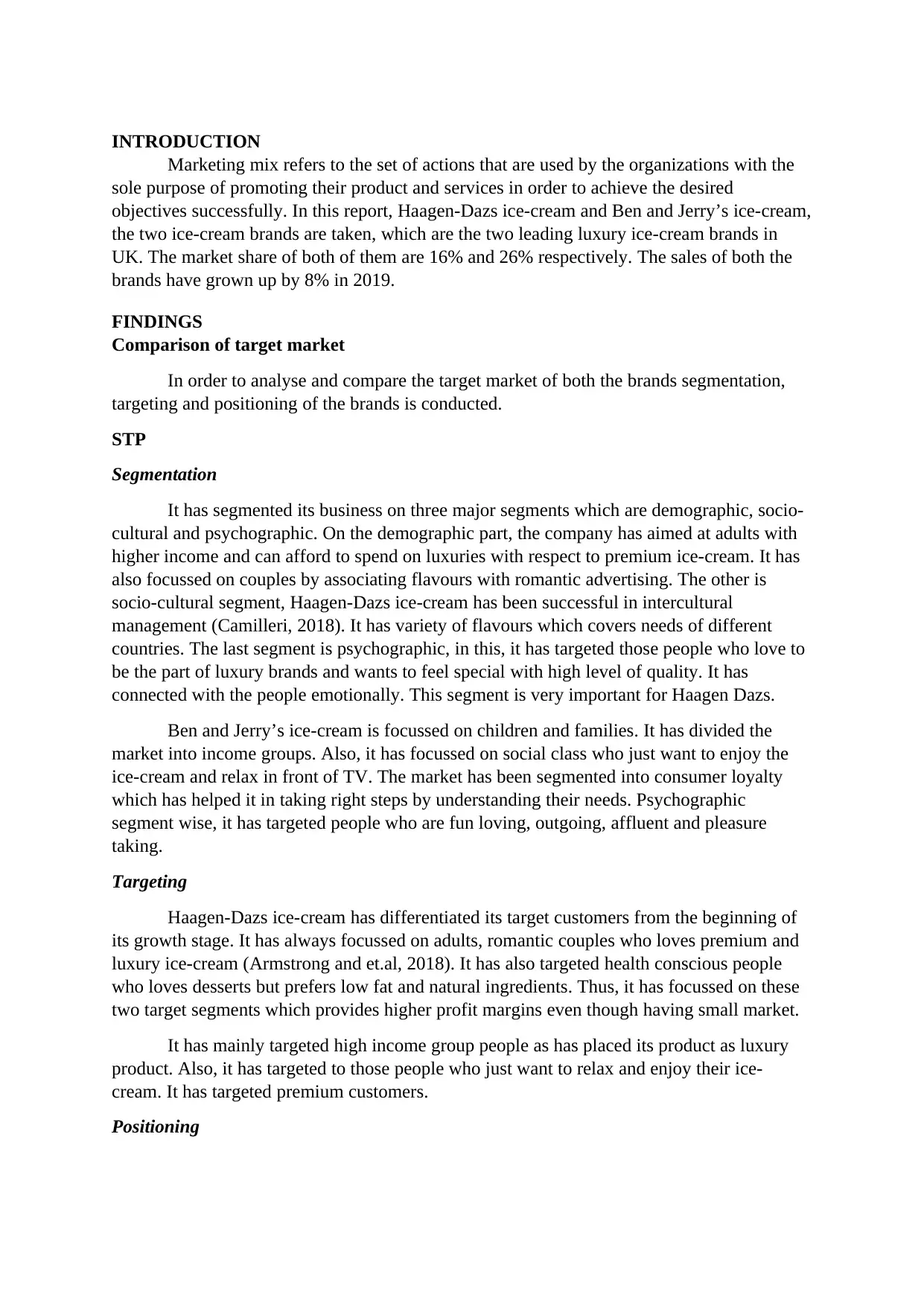
INTRODUCTION
Marketing mix refers to the set of actions that are used by the organizations with the
sole purpose of promoting their product and services in order to achieve the desired
objectives successfully. In this report, Haagen-Dazs ice-cream and Ben and Jerry’s ice-cream,
the two ice-cream brands are taken, which are the two leading luxury ice-cream brands in
UK. The market share of both of them are 16% and 26% respectively. The sales of both the
brands have grown up by 8% in 2019.
FINDINGS
Comparison of target market
In order to analyse and compare the target market of both the brands segmentation,
targeting and positioning of the brands is conducted.
STP
Segmentation
It has segmented its business on three major segments which are demographic, socio-
cultural and psychographic. On the demographic part, the company has aimed at adults with
higher income and can afford to spend on luxuries with respect to premium ice-cream. It has
also focussed on couples by associating flavours with romantic advertising. The other is
socio-cultural segment, Haagen-Dazs ice-cream has been successful in intercultural
management (Camilleri, 2018). It has variety of flavours which covers needs of different
countries. The last segment is psychographic, in this, it has targeted those people who love to
be the part of luxury brands and wants to feel special with high level of quality. It has
connected with the people emotionally. This segment is very important for Haagen Dazs.
Ben and Jerry’s ice-cream is focussed on children and families. It has divided the
market into income groups. Also, it has focussed on social class who just want to enjoy the
ice-cream and relax in front of TV. The market has been segmented into consumer loyalty
which has helped it in taking right steps by understanding their needs. Psychographic
segment wise, it has targeted people who are fun loving, outgoing, affluent and pleasure
taking.
Targeting
Haagen-Dazs ice-cream has differentiated its target customers from the beginning of
its growth stage. It has always focussed on adults, romantic couples who loves premium and
luxury ice-cream (Armstrong and et.al, 2018). It has also targeted health conscious people
who loves desserts but prefers low fat and natural ingredients. Thus, it has focussed on these
two target segments which provides higher profit margins even though having small market.
It has mainly targeted high income group people as has placed its product as luxury
product. Also, it has targeted to those people who just want to relax and enjoy their ice-
cream. It has targeted premium customers.
Positioning
Marketing mix refers to the set of actions that are used by the organizations with the
sole purpose of promoting their product and services in order to achieve the desired
objectives successfully. In this report, Haagen-Dazs ice-cream and Ben and Jerry’s ice-cream,
the two ice-cream brands are taken, which are the two leading luxury ice-cream brands in
UK. The market share of both of them are 16% and 26% respectively. The sales of both the
brands have grown up by 8% in 2019.
FINDINGS
Comparison of target market
In order to analyse and compare the target market of both the brands segmentation,
targeting and positioning of the brands is conducted.
STP
Segmentation
It has segmented its business on three major segments which are demographic, socio-
cultural and psychographic. On the demographic part, the company has aimed at adults with
higher income and can afford to spend on luxuries with respect to premium ice-cream. It has
also focussed on couples by associating flavours with romantic advertising. The other is
socio-cultural segment, Haagen-Dazs ice-cream has been successful in intercultural
management (Camilleri, 2018). It has variety of flavours which covers needs of different
countries. The last segment is psychographic, in this, it has targeted those people who love to
be the part of luxury brands and wants to feel special with high level of quality. It has
connected with the people emotionally. This segment is very important for Haagen Dazs.
Ben and Jerry’s ice-cream is focussed on children and families. It has divided the
market into income groups. Also, it has focussed on social class who just want to enjoy the
ice-cream and relax in front of TV. The market has been segmented into consumer loyalty
which has helped it in taking right steps by understanding their needs. Psychographic
segment wise, it has targeted people who are fun loving, outgoing, affluent and pleasure
taking.
Targeting
Haagen-Dazs ice-cream has differentiated its target customers from the beginning of
its growth stage. It has always focussed on adults, romantic couples who loves premium and
luxury ice-cream (Armstrong and et.al, 2018). It has also targeted health conscious people
who loves desserts but prefers low fat and natural ingredients. Thus, it has focussed on these
two target segments which provides higher profit margins even though having small market.
It has mainly targeted high income group people as has placed its product as luxury
product. Also, it has targeted to those people who just want to relax and enjoy their ice-
cream. It has targeted premium customers.
Positioning
⊘ This is a preview!⊘
Do you want full access?
Subscribe today to unlock all pages.

Trusted by 1+ million students worldwide
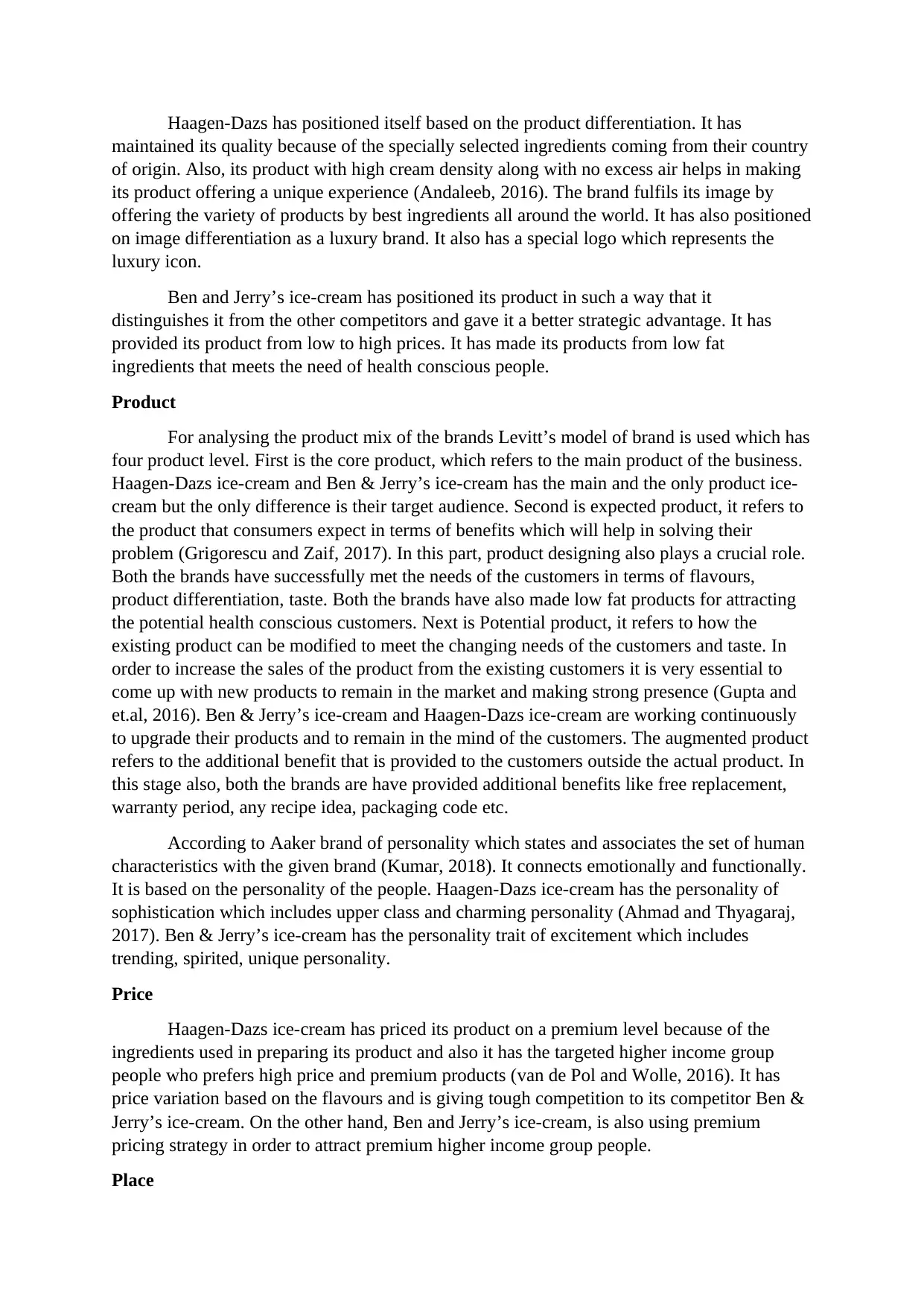
Haagen-Dazs has positioned itself based on the product differentiation. It has
maintained its quality because of the specially selected ingredients coming from their country
of origin. Also, its product with high cream density along with no excess air helps in making
its product offering a unique experience (Andaleeb, 2016). The brand fulfils its image by
offering the variety of products by best ingredients all around the world. It has also positioned
on image differentiation as a luxury brand. It also has a special logo which represents the
luxury icon.
Ben and Jerry’s ice-cream has positioned its product in such a way that it
distinguishes it from the other competitors and gave it a better strategic advantage. It has
provided its product from low to high prices. It has made its products from low fat
ingredients that meets the need of health conscious people.
Product
For analysing the product mix of the brands Levitt’s model of brand is used which has
four product level. First is the core product, which refers to the main product of the business.
Haagen-Dazs ice-cream and Ben & Jerry’s ice-cream has the main and the only product ice-
cream but the only difference is their target audience. Second is expected product, it refers to
the product that consumers expect in terms of benefits which will help in solving their
problem (Grigorescu and Zaif, 2017). In this part, product designing also plays a crucial role.
Both the brands have successfully met the needs of the customers in terms of flavours,
product differentiation, taste. Both the brands have also made low fat products for attracting
the potential health conscious customers. Next is Potential product, it refers to how the
existing product can be modified to meet the changing needs of the customers and taste. In
order to increase the sales of the product from the existing customers it is very essential to
come up with new products to remain in the market and making strong presence (Gupta and
et.al, 2016). Ben & Jerry’s ice-cream and Haagen-Dazs ice-cream are working continuously
to upgrade their products and to remain in the mind of the customers. The augmented product
refers to the additional benefit that is provided to the customers outside the actual product. In
this stage also, both the brands are have provided additional benefits like free replacement,
warranty period, any recipe idea, packaging code etc.
According to Aaker brand of personality which states and associates the set of human
characteristics with the given brand (Kumar, 2018). It connects emotionally and functionally.
It is based on the personality of the people. Haagen-Dazs ice-cream has the personality of
sophistication which includes upper class and charming personality (Ahmad and Thyagaraj,
2017). Ben & Jerry’s ice-cream has the personality trait of excitement which includes
trending, spirited, unique personality.
Price
Haagen-Dazs ice-cream has priced its product on a premium level because of the
ingredients used in preparing its product and also it has the targeted higher income group
people who prefers high price and premium products (van de Pol and Wolle, 2016). It has
price variation based on the flavours and is giving tough competition to its competitor Ben &
Jerry’s ice-cream. On the other hand, Ben and Jerry’s ice-cream, is also using premium
pricing strategy in order to attract premium higher income group people.
Place
maintained its quality because of the specially selected ingredients coming from their country
of origin. Also, its product with high cream density along with no excess air helps in making
its product offering a unique experience (Andaleeb, 2016). The brand fulfils its image by
offering the variety of products by best ingredients all around the world. It has also positioned
on image differentiation as a luxury brand. It also has a special logo which represents the
luxury icon.
Ben and Jerry’s ice-cream has positioned its product in such a way that it
distinguishes it from the other competitors and gave it a better strategic advantage. It has
provided its product from low to high prices. It has made its products from low fat
ingredients that meets the need of health conscious people.
Product
For analysing the product mix of the brands Levitt’s model of brand is used which has
four product level. First is the core product, which refers to the main product of the business.
Haagen-Dazs ice-cream and Ben & Jerry’s ice-cream has the main and the only product ice-
cream but the only difference is their target audience. Second is expected product, it refers to
the product that consumers expect in terms of benefits which will help in solving their
problem (Grigorescu and Zaif, 2017). In this part, product designing also plays a crucial role.
Both the brands have successfully met the needs of the customers in terms of flavours,
product differentiation, taste. Both the brands have also made low fat products for attracting
the potential health conscious customers. Next is Potential product, it refers to how the
existing product can be modified to meet the changing needs of the customers and taste. In
order to increase the sales of the product from the existing customers it is very essential to
come up with new products to remain in the market and making strong presence (Gupta and
et.al, 2016). Ben & Jerry’s ice-cream and Haagen-Dazs ice-cream are working continuously
to upgrade their products and to remain in the mind of the customers. The augmented product
refers to the additional benefit that is provided to the customers outside the actual product. In
this stage also, both the brands are have provided additional benefits like free replacement,
warranty period, any recipe idea, packaging code etc.
According to Aaker brand of personality which states and associates the set of human
characteristics with the given brand (Kumar, 2018). It connects emotionally and functionally.
It is based on the personality of the people. Haagen-Dazs ice-cream has the personality of
sophistication which includes upper class and charming personality (Ahmad and Thyagaraj,
2017). Ben & Jerry’s ice-cream has the personality trait of excitement which includes
trending, spirited, unique personality.
Price
Haagen-Dazs ice-cream has priced its product on a premium level because of the
ingredients used in preparing its product and also it has the targeted higher income group
people who prefers high price and premium products (van de Pol and Wolle, 2016). It has
price variation based on the flavours and is giving tough competition to its competitor Ben &
Jerry’s ice-cream. On the other hand, Ben and Jerry’s ice-cream, is also using premium
pricing strategy in order to attract premium higher income group people.
Place
Paraphrase This Document
Need a fresh take? Get an instant paraphrase of this document with our AI Paraphraser
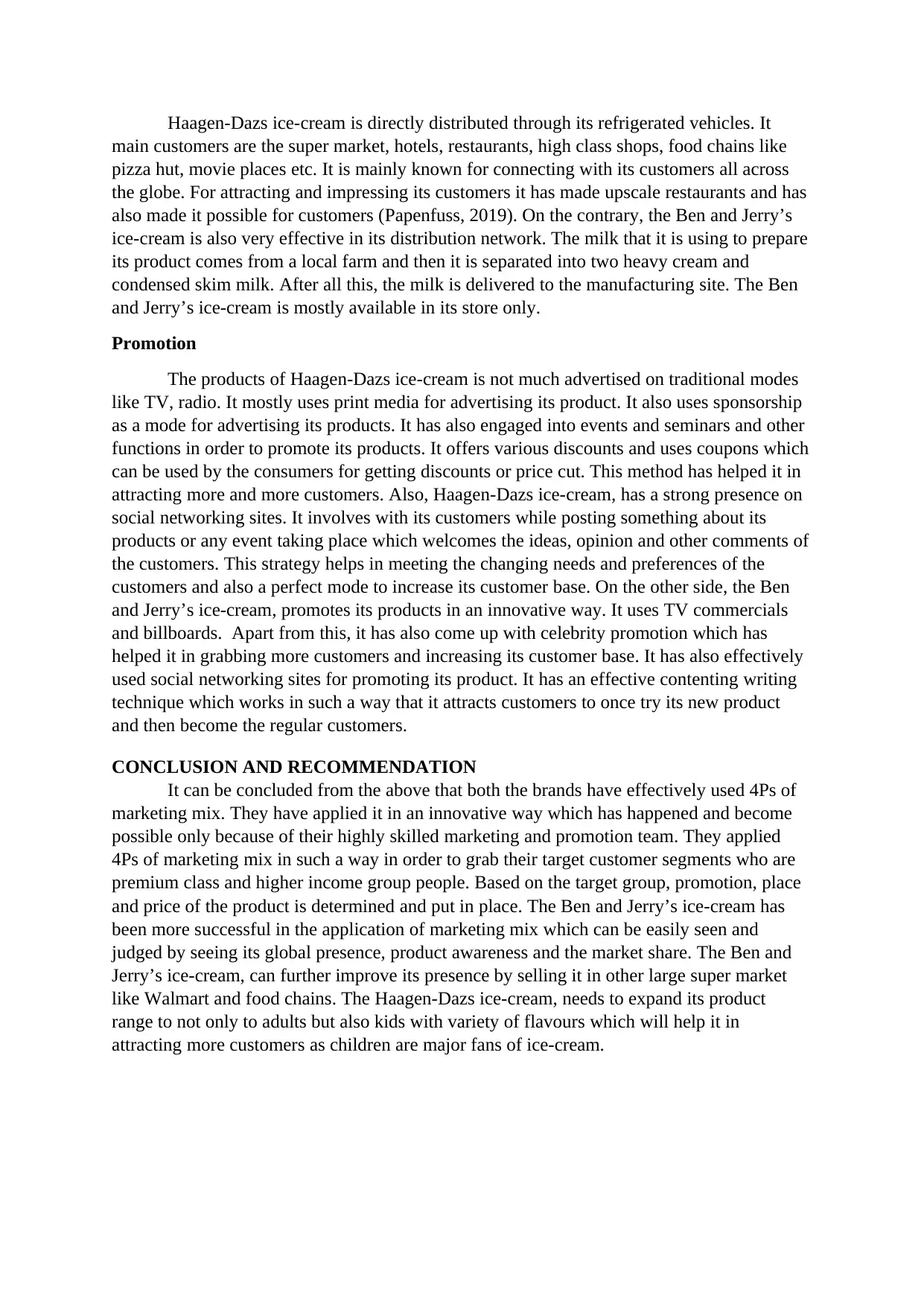
Haagen-Dazs ice-cream is directly distributed through its refrigerated vehicles. It
main customers are the super market, hotels, restaurants, high class shops, food chains like
pizza hut, movie places etc. It is mainly known for connecting with its customers all across
the globe. For attracting and impressing its customers it has made upscale restaurants and has
also made it possible for customers (Papenfuss, 2019). On the contrary, the Ben and Jerry’s
ice-cream is also very effective in its distribution network. The milk that it is using to prepare
its product comes from a local farm and then it is separated into two heavy cream and
condensed skim milk. After all this, the milk is delivered to the manufacturing site. The Ben
and Jerry’s ice-cream is mostly available in its store only.
Promotion
The products of Haagen-Dazs ice-cream is not much advertised on traditional modes
like TV, radio. It mostly uses print media for advertising its product. It also uses sponsorship
as a mode for advertising its products. It has also engaged into events and seminars and other
functions in order to promote its products. It offers various discounts and uses coupons which
can be used by the consumers for getting discounts or price cut. This method has helped it in
attracting more and more customers. Also, Haagen-Dazs ice-cream, has a strong presence on
social networking sites. It involves with its customers while posting something about its
products or any event taking place which welcomes the ideas, opinion and other comments of
the customers. This strategy helps in meeting the changing needs and preferences of the
customers and also a perfect mode to increase its customer base. On the other side, the Ben
and Jerry’s ice-cream, promotes its products in an innovative way. It uses TV commercials
and billboards. Apart from this, it has also come up with celebrity promotion which has
helped it in grabbing more customers and increasing its customer base. It has also effectively
used social networking sites for promoting its product. It has an effective contenting writing
technique which works in such a way that it attracts customers to once try its new product
and then become the regular customers.
CONCLUSION AND RECOMMENDATION
It can be concluded from the above that both the brands have effectively used 4Ps of
marketing mix. They have applied it in an innovative way which has happened and become
possible only because of their highly skilled marketing and promotion team. They applied
4Ps of marketing mix in such a way in order to grab their target customer segments who are
premium class and higher income group people. Based on the target group, promotion, place
and price of the product is determined and put in place. The Ben and Jerry’s ice-cream has
been more successful in the application of marketing mix which can be easily seen and
judged by seeing its global presence, product awareness and the market share. The Ben and
Jerry’s ice-cream, can further improve its presence by selling it in other large super market
like Walmart and food chains. The Haagen-Dazs ice-cream, needs to expand its product
range to not only to adults but also kids with variety of flavours which will help it in
attracting more customers as children are major fans of ice-cream.
main customers are the super market, hotels, restaurants, high class shops, food chains like
pizza hut, movie places etc. It is mainly known for connecting with its customers all across
the globe. For attracting and impressing its customers it has made upscale restaurants and has
also made it possible for customers (Papenfuss, 2019). On the contrary, the Ben and Jerry’s
ice-cream is also very effective in its distribution network. The milk that it is using to prepare
its product comes from a local farm and then it is separated into two heavy cream and
condensed skim milk. After all this, the milk is delivered to the manufacturing site. The Ben
and Jerry’s ice-cream is mostly available in its store only.
Promotion
The products of Haagen-Dazs ice-cream is not much advertised on traditional modes
like TV, radio. It mostly uses print media for advertising its product. It also uses sponsorship
as a mode for advertising its products. It has also engaged into events and seminars and other
functions in order to promote its products. It offers various discounts and uses coupons which
can be used by the consumers for getting discounts or price cut. This method has helped it in
attracting more and more customers. Also, Haagen-Dazs ice-cream, has a strong presence on
social networking sites. It involves with its customers while posting something about its
products or any event taking place which welcomes the ideas, opinion and other comments of
the customers. This strategy helps in meeting the changing needs and preferences of the
customers and also a perfect mode to increase its customer base. On the other side, the Ben
and Jerry’s ice-cream, promotes its products in an innovative way. It uses TV commercials
and billboards. Apart from this, it has also come up with celebrity promotion which has
helped it in grabbing more customers and increasing its customer base. It has also effectively
used social networking sites for promoting its product. It has an effective contenting writing
technique which works in such a way that it attracts customers to once try its new product
and then become the regular customers.
CONCLUSION AND RECOMMENDATION
It can be concluded from the above that both the brands have effectively used 4Ps of
marketing mix. They have applied it in an innovative way which has happened and become
possible only because of their highly skilled marketing and promotion team. They applied
4Ps of marketing mix in such a way in order to grab their target customer segments who are
premium class and higher income group people. Based on the target group, promotion, place
and price of the product is determined and put in place. The Ben and Jerry’s ice-cream has
been more successful in the application of marketing mix which can be easily seen and
judged by seeing its global presence, product awareness and the market share. The Ben and
Jerry’s ice-cream, can further improve its presence by selling it in other large super market
like Walmart and food chains. The Haagen-Dazs ice-cream, needs to expand its product
range to not only to adults but also kids with variety of flavours which will help it in
attracting more customers as children are major fans of ice-cream.
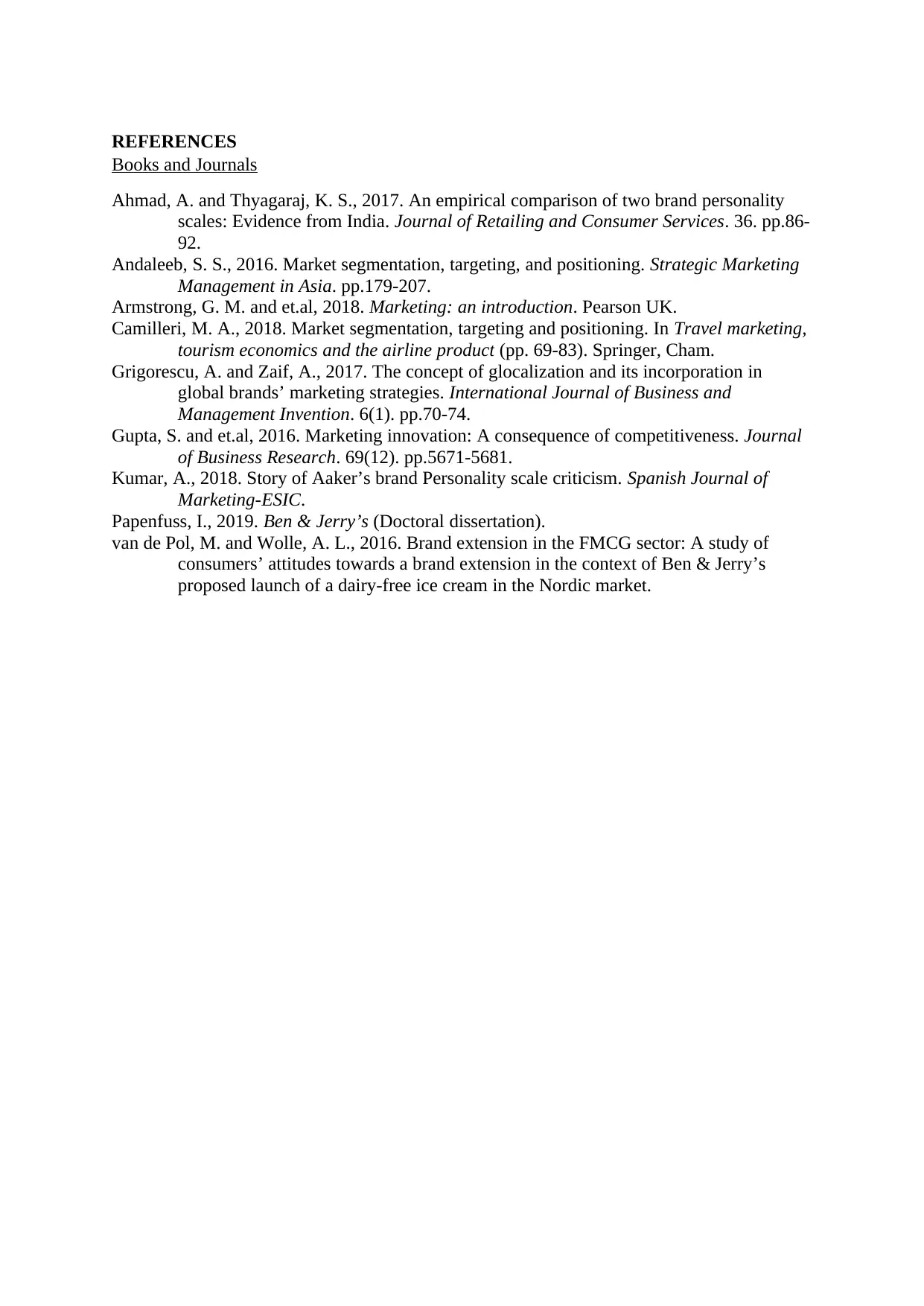
REFERENCES
Books and Journals
Ahmad, A. and Thyagaraj, K. S., 2017. An empirical comparison of two brand personality
scales: Evidence from India. Journal of Retailing and Consumer Services. 36. pp.86-
92.
Andaleeb, S. S., 2016. Market segmentation, targeting, and positioning. Strategic Marketing
Management in Asia. pp.179-207.
Armstrong, G. M. and et.al, 2018. Marketing: an introduction. Pearson UK.
Camilleri, M. A., 2018. Market segmentation, targeting and positioning. In Travel marketing,
tourism economics and the airline product (pp. 69-83). Springer, Cham.
Grigorescu, A. and Zaif, A., 2017. The concept of glocalization and its incorporation in
global brands’ marketing strategies. International Journal of Business and
Management Invention. 6(1). pp.70-74.
Gupta, S. and et.al, 2016. Marketing innovation: A consequence of competitiveness. Journal
of Business Research. 69(12). pp.5671-5681.
Kumar, A., 2018. Story of Aaker’s brand Personality scale criticism. Spanish Journal of
Marketing-ESIC.
Papenfuss, I., 2019. Ben & Jerry’s (Doctoral dissertation).
van de Pol, M. and Wolle, A. L., 2016. Brand extension in the FMCG sector: A study of
consumers’ attitudes towards a brand extension in the context of Ben & Jerry’s
proposed launch of a dairy-free ice cream in the Nordic market.
Books and Journals
Ahmad, A. and Thyagaraj, K. S., 2017. An empirical comparison of two brand personality
scales: Evidence from India. Journal of Retailing and Consumer Services. 36. pp.86-
92.
Andaleeb, S. S., 2016. Market segmentation, targeting, and positioning. Strategic Marketing
Management in Asia. pp.179-207.
Armstrong, G. M. and et.al, 2018. Marketing: an introduction. Pearson UK.
Camilleri, M. A., 2018. Market segmentation, targeting and positioning. In Travel marketing,
tourism economics and the airline product (pp. 69-83). Springer, Cham.
Grigorescu, A. and Zaif, A., 2017. The concept of glocalization and its incorporation in
global brands’ marketing strategies. International Journal of Business and
Management Invention. 6(1). pp.70-74.
Gupta, S. and et.al, 2016. Marketing innovation: A consequence of competitiveness. Journal
of Business Research. 69(12). pp.5671-5681.
Kumar, A., 2018. Story of Aaker’s brand Personality scale criticism. Spanish Journal of
Marketing-ESIC.
Papenfuss, I., 2019. Ben & Jerry’s (Doctoral dissertation).
van de Pol, M. and Wolle, A. L., 2016. Brand extension in the FMCG sector: A study of
consumers’ attitudes towards a brand extension in the context of Ben & Jerry’s
proposed launch of a dairy-free ice cream in the Nordic market.
⊘ This is a preview!⊘
Do you want full access?
Subscribe today to unlock all pages.

Trusted by 1+ million students worldwide
1 out of 6
Related Documents
Your All-in-One AI-Powered Toolkit for Academic Success.
+13062052269
info@desklib.com
Available 24*7 on WhatsApp / Email
![[object Object]](/_next/static/media/star-bottom.7253800d.svg)
Unlock your academic potential
Copyright © 2020–2025 A2Z Services. All Rights Reserved. Developed and managed by ZUCOL.





